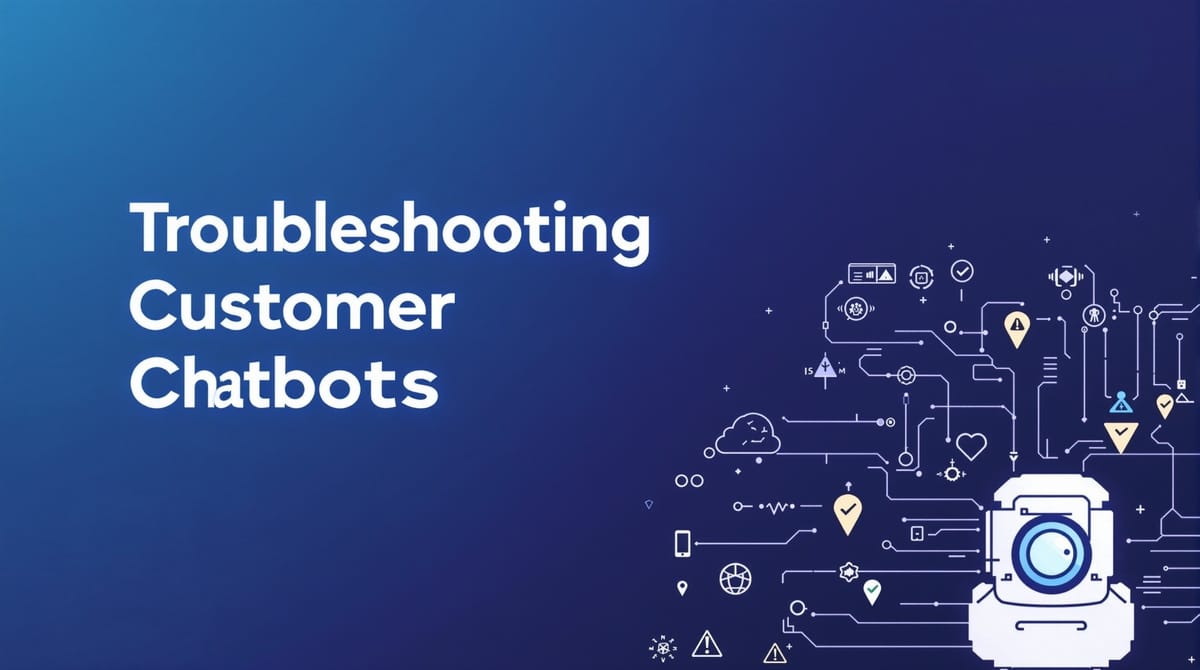Troubleshooting AI‑powered Customer Experience Chatbots: A Practical Guide
Discover how to troubleshoot common problems in AI-powered customer experience chatbots. This practical guide outlines typical failure points, root causes, and proven fixes to help teams stabilize, refine, and improve their AI implementations with confidence.

It is surprisingly easy to get AI implementations wrong. Many teams move fast to deploy a chatbot, expecting instant impact. What they often discover is that these systems break in subtle ways. The issues range from inaccurate answers to poor integrations and inconsistent tone. This happens far more often than most people anticipate.
In the following guide, we cover the most common ways AI chatbots run into problems. Each section explains what might be going wrong, why it happens, and how to fix it. It should help you troubleshoot and resolve most of your issues before they affect users or performance.
If you are facing a new or unusual problem that is not covered here, leave us a comment. We will be glad to help you work through it.
Quick triage flow
Before you begin troubleshooting, gather the right information. A good triage depends on clear evidence. Teams often waste hours chasing symptoms when the data they need is missing or inconsistent. Make sure logs, transcripts, and configuration details are available before you start. Having this foundation will make every step of your investigation faster and more reliable.
- Reproduce the issue Get the exact conversation. Keep the transcript id. Capture timestamps.
- Collect raw data Save user text. Save the full model prompt. Save all tool inputs and outputs.
- Check safety and filters Review moderation logs. Confirm PII handling. Note any blocks.
- Inspect retrieval Log documents. Track hit rate. Verify citations.
- Inspect the model call Note token counts. Check temperature and penalties. Check system and developer prompts.
- Inspect integrations Validate API keys. Check timeouts. Review HTTP status codes.
- Inspect session state Confirm memory keys. Check user profile loads. Verify context carryover.
- Check recent changes List deployments. List config changes. Note model or index swaps.
- Apply a safe stopgap Tighten instructions. Lower temperature. Add a fallback or handoff.
Symptom to cause map
Common problem scenarios and fixes
1) Wrong or invented answers
Why it happens Grounding is weak. Retrieval misses. Content is stale. Prompts are vague.
How to confirm Check retrieval hit rate. Inspect top k docs. Run a faithfulness check against sources.
Fix it fast Narrow scope. Require citations. Lower temperature. Add a safe fallback.
Fix it right Adopt retrieval augmented generation. Improve chunking and metadata. Rebuild the index on a schedule. Add a test set with labeled truths.
2) Cannot access customer data
Why it happens Broken API paths. Expired tokens. Missing scopes. Entity resolution fails.
How to confirm Check tool call logs. Review HTTP status codes. Verify auth headers.
Fix it fast Rotate secrets. Add request retries. Validate inputs before calls.
Fix it right Define strict tool schemas. Add contract tests. Create sandbox fixtures. Monitor tool success rate.
3) High latency or timeouts
Why it happens Huge prompts. Slow upstream systems. Too many sequential tools.
How to confirm Plot latency p50 and p95 by step. Inspect token counts. Trace each tool hop.
Fix it fast Stream partial replies. Trim context. Cache frequent answers.
Fix it right Enforce token budgets. Parallelize safe calls. Add a response cache with TTL. Set timeouts per tool.
4) Repetition or loops
Why it happens State is not stored. Memory keys collide. Fallback logic re‑prompts.
How to confirm Watch turn counters. Inspect session writes. Review guard conditions.
Fix it fast Add a max turn cap. Add loop detection. Switch to human after two failures.
Fix it right Design state machines. Persist slots. Add negative tests for loops.
5) Tone and brand drift
Why it happens No style guide. No examples. Randomness is high.
How to confirm Sample transcripts. Score tone consistency.
Fix it fast Add a style section in the system prompt. Provide two or three examples. Lower temperature.
Fix it right Build a small tone classifier. Reject off‑brand replies. Train with brand data.
6) Intent confusion
Why it happens No intent model. Labels are muddy. Edge cases are unknown.
How to confirm Build a confusion matrix. Review misroutes.
Fix it fast Introduce a light intent router. Add a “clarify intent” step.
Fix it right Define canonical intents. Create balanced training data. Add few‑shot examples per intent.
7) Retrieval misses and stale content
Why it happens Poor chunk size. Weak analyzers. No synonyms. No scheduled refresh.
How to confirm Audit missed queries. Check index freshness. Test hit at k.
Fix it fast Add synonyms. Add query expansion. Blend keyword and vector search.
Fix it right Version the index. Enrich documents with metadata. Refresh on a calendar. Track recall as a metric.
8) Safety and compliance slips
Why it happens No policy. No red teaming. Filters are too late in the flow.
How to confirm Search for PII in logs. Run jailbreak prompts. Review refusal rates.
Fix it fast Mask PII at ingestion. Add pre and post filters. Add refusal templates.
Fix it right Write policy rules. Add automated red team tests. Log and audit every high‑risk action.
9) Prompt injection and tool misuse
Why it happens The model trusts user text. Tools are over‑exposed. Outputs are not scanned.
How to confirm Test with known exploits. Review prompts that change behavior.
Fix it fast Separate user text from instructions. Use allowlists. Validate tool arguments.
Fix it right Add content provenance. Add output scanning. Gate tools behind policies.
10) Multilingual and locale issues
Why it happens No language detection. English only index. Locale rules are missing.
How to confirm Check language id. Compare reply language to user language.
Fix it fast Enable detection. Translate queries and results. Mirror UI language.
Fix it right Build per language indexes. Localize templates. Add currency and date rules.
11) Personalization and context loss
Why it happens Session expires. Memory is not scoped. Profiles load too late.
How to confirm Trace state across turns. Verify profile fetch timing.
Fix it fast Load profile at start. Store key facts. Set a clear session TTL.
Fix it right Design a privacy aware memory store. Add user consent. Add memory cleanup jobs.
12) Cost overruns
Why it happens Large prompts. Verbose outputs. High retry counts. Overuse of top models.
How to confirm Track tokens by feature. Track retries. Track model mix.
Fix it fast Cap max tokens. Use concise templates. Add stop reasons.
Fix it right Right‑size the model per task. Summarize history. Cache stable steps. Set per team budgets.
13) Handoff to human fails
Why it happens No trigger rules. No staffing coverage. No identity handover.
How to confirm Check handoff rate. Review queue status. Inspect context packets.
Fix it fast Add a manual “talk to a person” command. Include transcript in the ticket.
Fix it right Define triggers. Share identity and consent. Measure handoff success.
14) Analytics blind spots
Why it happens No events. No standards. No dashboards.
How to confirm List tracked events. Check report freshness. Ask three key questions you cannot answer.
Fix it fast Log message, intent, tool call, and outcome. Add a daily report.
Fix it right Adopt a data spec. Build a quality review loop. Sample transcripts each week.
Metrics that matter
Track a small set with clear targets.
- Containment rate Percent of conversations solved by the bot. Target by use case.
- Grounded accuracy Percent of answers that match sources. Use human labels to record this one.
- Full resolution time Time taken to complete final action or handoff.
- Safety violation rate Flagged or blocked outputs per 1,000 messages.
- CSAT or effort score Simple one click survey. Tie this one to the transcript id.
Release and maintenance rituals
Before release
- Run the preflight checklist(see below).
- Reindex changed content.
- Backtest against the golden set.
- Test load and latency.
- Review safety outcomes.
Weekly
- Refresh analytics.
- Audit ten random transcripts.
- Review top failure intents.
Security and compliance basics
- Mask PII at ingestion.
- Store only what you need.
- Encrypt at rest and in transit.
- Limit tool scopes.
- Add rate limits.
- Keep an audit trail.
- Document data retention.
- Give users export and deletion controls.
Preflight checklist
Use this before you ship anything.
- Goals and success metrics are written down.
- System prompt is versioned and documented.
- Style guides and examples must be set up.
- Index all current content.
- Golden set passes.
- Safety checks pass.
- Human handoff works.
- Dashboards are being updated daily.
Closing thoughts
Good chatbots are simple on the surface. The hard work sits behind them. Strong retrieval. Clear prompts. Safe tools. Clean data. Watch a few metrics. Fix small things often. Trust grows turn by turn.


